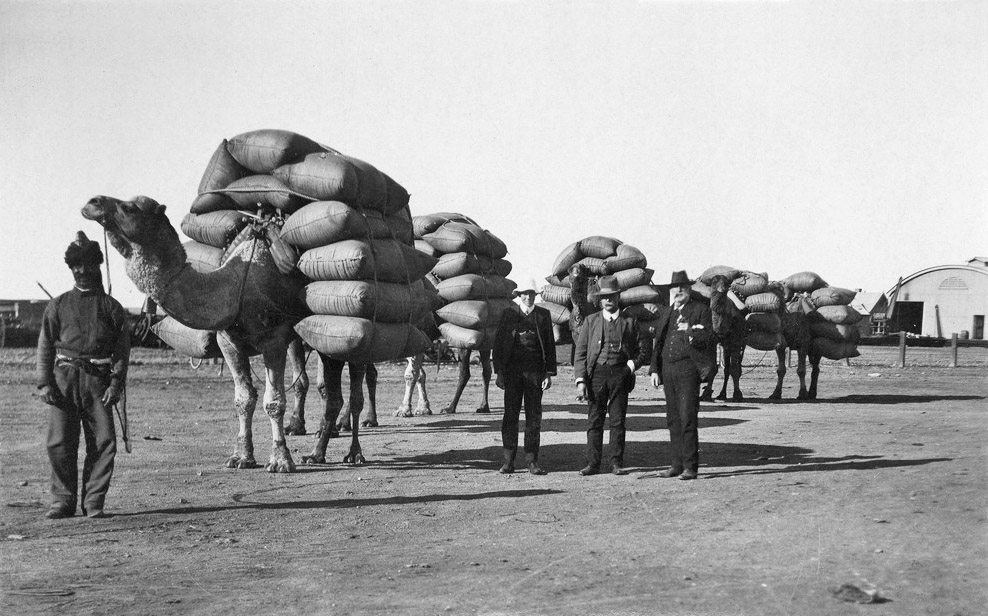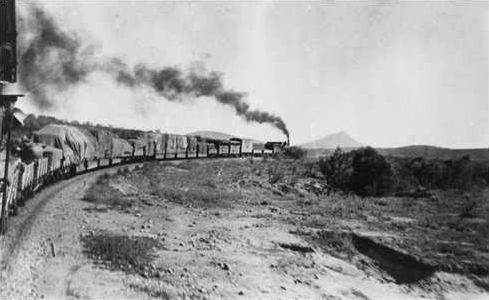The Afghans
Between 1870 and 1920 approximately 20,000 camels and between 2000 and 4000 cameleers landed at ports around Australia to support a vast network of camel train routes that spread out across inland Australia. Camels arrived in their hundreds on ships from Karachi and Bombay and excited crowds flocked to the wharves to see the animals unloaded after their long sea trip.
The camel was ideally suited to Australia's desert environment, where horses and buffaloes died through lack of water. But if camels were to be used, experienced handlers were indispensable and so men, from what was then an undivided India and Kingdom of Afghanistan (today Pakistan, India, and Afghanistan) were 'imported' by British entrepreneurs along with the camels – collectively the men were known as "Afghans" or "Ghans".
Cameleers undertook what needed to be done when a big country is being opened up – accompanying exploratory expeditions, carting wool to ports or railheads, barrels of water to drought-ridden areas, transporting mail, construction materials and stores at a time when railway construction was in its infancy.
Many rest stations opened up across the country, where camel teams converged as they moved from one state to another, and centres such as Marree became established, opening lines of supply to isolated communities inland or further north.
By the mid-1890s, the "Ghans" were becoming a 'problem' resented by those who believed that they threatened the working conditions of white Australians. Along with Chinese goldfield workers and Pacific Islanders employed in the sugar cane industry, the Afghans became targets of anti-Asian sentiment as the colonies approached the Federation. This eventually led to the passage of the Immigration Restriction Act of 1901, known as the White Australia Policy. The Menzies and Holt Governments effectively dismantled this policy between 1949 and 1966, and the Whitlam Government in 1973 passed laws to ensure that race would be totally disregarded as a factor for immigration to Australia.
The Afghan cameleers led hard lives in this country, and their wives and children were at first prevented from entering Australia, a restriction not lifted until the late 1920s. Some married and raised families with Anglo-Australian or Indigenous women. Today their descendants take pride in the pioneering role played by their ancestors and kinsmen in Australian history.

'The Ghan'
During the cool months of 1923, the South Australian Railways decided to shorten the time taken by trains for passengers and perishable freight between Adelaide and Oodnadatta. Before this time, trains had stopped overnight at stations en-route, including Quorn. After 1923, a sleeping car was provided and the train rescheduled to continue without stabling overnight. Through passengers could leave Adelaide a day later, on Thursday mornings, and return a day earlier than under the previous timetable.
On 30 August 1923, the inaugural through passenger train, which included the Alberga sleeping car, left Terowie for Oodnadatta. It was on this trip that the name 'The Ghan' had its origin. A large crowd of local people gathered at the Quorn station to witness the arrival of the new train with its sleeping car.
According to the timetable, it was 8.40pm when the train pulled into Quorn yard. An Afghan passenger wasted no time in getting off the train and sprinting to a quiet corner of the yard, where he could kneel to face Mecca and recite his ritual evening prayers. A railwayman, now identified as SAR Engine Driver Ernie Smith (AFULE shop steward and great-grandfather of Hindmarsh Federal MP Mark Butler) made the joking remark that, if he was the only passenger on the train, "We'll have to call it the Afghan Express".
The name proved popular and was adopted immediately, later being shortened to the 'Ghan Express', and then to 'The Ghan', by which name the train was known to local railwaymen for several years prior to the takeover by the Commonwealth Railways in 1926.
There are many versions of how 'The Ghan' received its name, including the official Commonwealth Railways explanation that the train was named in honour of pioneer Afghan cameleers, but local opinion is the name was bestowed in 1923 when the first sleeping car train worked on the Great Northern Railway. Others suggest the name is derived from an observation that 'The Ghan', when extended to Alice Springs, superseded the Afghans and their strings of camels. However, this explanation, and the commemorative plaque unveiled at the Alice Springs Railway Station in October 1980, contradict historical fact - that the famous 'Ghan' derived it's name from an event in Quorn when the first sleeping car service was introduced between Terowie and Oodnadatta—six years before a train steamed into Alice Springs.
'The Ghan' ran from Port Augusta to Alice Springs via Quorn until 13 August 1956 and then operated via the new standard gauge line west of the Flinders Ranges (to Copley initially) to Marree, where there was a break of gauge and passengers changed trains back on to the narrow gauge line to continue to Alice Springs.
'The Ghan' continued to run on narrow gauge tracks from Marree to Alice Springs via Oodnadatta and Finke until 28 November 1980.
The first all standard gauge 'Ghan' to Alice Springs via Port Augusta and Tarcoola departed Adelaide on 4 December 1980 and continues to operate as a very successful tourist attraction.
It is fitting that 'the Ghan' name should serve to perpetuate the memory of that hardy band of gentle but tough men who supplied and provisioned the outback with their camel teams in the early years.


- Williams, AG (George) - contemporaneous records
- Babbage, J & Barrington, R "The History of Pichi Richi Railway" PRRPS, Quorn 1984
- Stevens, Christine "Tin Mosques and Ghantowns - A History of Afghan Cameldrivers in Australia" Paul Fitzsimons, Alice Springs 2002
- Dean, H: "Boundless Plains: The Australian Muslim Connection" Thornbury, Victoria 2012
- Wilson J, "The Train to Oodna Woop-Woop - A social history of The Afghan Express" SARLines Books, Adelaide 2021
